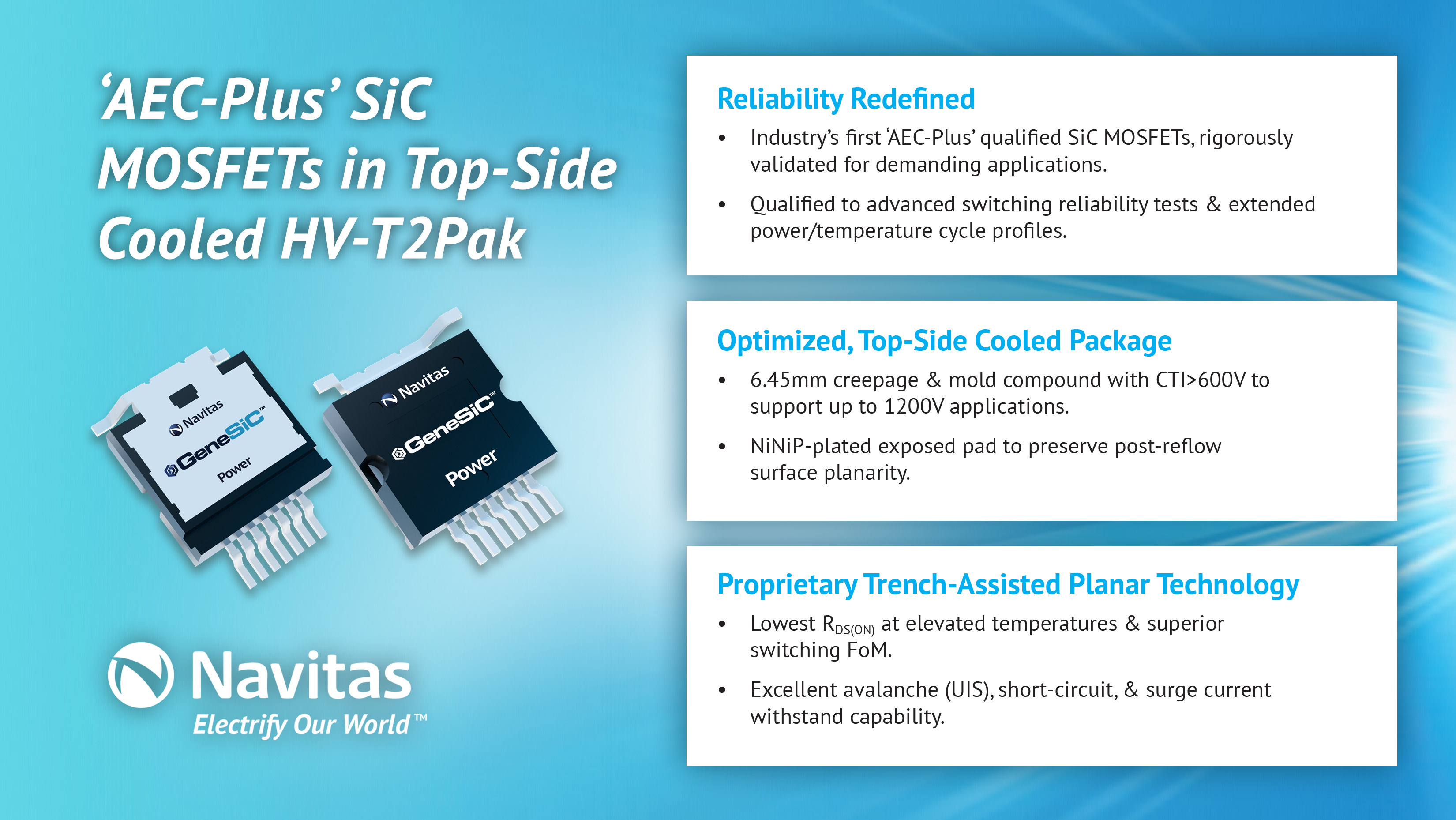Navitas Redefines Reliability with Industry’s First Automotive ‘AEC-Plus’ Qualified SiC MOSFETs in HV-T2Pak Top-Side Cooled Package
- Industry-first AEC-Plus qualification exceeding automotive standards
- 20% lower on-resistance under high-temperature operation vs competition
- Highest creepage of 6.45mm in the industry for 1200V applications
- Superior thermal management with innovative package design
- Expanded product portfolio covering both 650V and 1200V applications
- None.
Insights
Navitas strengthens its SiC portfolio with higher-reliability MOSFETs featuring improved thermal performance and safety margins for mission-critical applications.
Navitas' introduction of SiC MOSFETs with their self-defined 'AEC-Plus' qualification standard represents meaningful technological advancement in power semiconductors. By exceeding the standard automotive AEC-Q101 requirements with features like 2x longer power & temperature cycling and 3x longer high-temperature/voltage testing, Navitas is addressing reliability concerns critical in demanding applications.
The innovative HV-T2Pak package design delivers 6.45 mm creepage (clearance distance along surfaces) without sacrificing thermal pad size - a significant engineering achievement that enables use in high-voltage systems while maintaining IEC compliance. The nickel/nickel-phosphorus (NiNiP) thermal pad plating, replacing traditional tin, demonstrates sophisticated packaging expertise by maintaining surface planarity after reflow soldering, ensuring optimal thermal interface material contact.
Technically, their 'trench-assisted planar' SiC MOSFET architecture delivers up to 20% lower on-resistance at high temperatures versus competitors. This directly translates to reduced conduction losses and higher efficiency in power conversion systems. The announced portfolio spans both 650V and 1200V ratings with on-resistances from 18 mΩ to 135 mΩ, covering applications from residential to industrial power levels.
The qualification to 200°C maximum junction temperature provides critical safety margin for transient overload conditions common in automotive and industrial environments. Their focus on dynamic testing methodologies (D-HTRB and D-HTGB) better represents real-world stress conditions compared to traditional static qualification tests.
From an automotive engineering perspective, these new SiC MOSFETs address several critical challenges in electric vehicle power systems. The enhanced reliability testing through Navitas' 'AEC-Plus' qualification directly targets the demanding lifetime requirements of automotive applications, where components must endure 10-15 years of operation in harsh thermal and electrical environments.
The dynamic switching tests more accurately replicate the stress conditions power semiconductors experience in EV inverters, onboard chargers, and DC-DC converters, where rapid switching under load creates significant thermal and electrical stress. For automotive designers concerned with system reliability, the 200°C maximum junction temperature rating provides essential margin for fault conditions and unexpected overloads.
The 6.45 mm creepage distance is particularly valuable as automotive systems transition to higher bus voltages (800V and beyond), requiring stricter isolation and clearance specifications to meet safety standards. This enables simpler power system designs while maintaining required safety margins without resorting to conformal coatings or other isolation techniques.
For EV thermal management engineers, the top-side cooling package with optimized NiNiP plating addresses key manufacturing concerns about thermal interface reliability over vehicle lifetime. In practical application, the 20% lower on-resistance in high-temperature operation directly impacts charging efficiency and thermal management requirements in onboard charger and DC-DC converter designs.
While many SiC devices meet basic AEC-Q101 standards, the extended qualification testing directly addresses automotive-specific concerns about power semiconductor reliability that have historically caused hesitation among some conservative automotive suppliers. This approach aligns with the industry trend toward more rigorous component qualification for safety-critical EV systems.
Unprecedented reliability combined with superior performance & optimized, high-creepage package sets a new benchmark in automotive and industrial applications
TORRANCE, Calif., May 05, 2025 (GLOBE NEWSWIRE) -- Navitas Semiconductor (Nasdaq: NVTS), the only pure-play, next-generation power semiconductor company and industry leader in gallium nitride (GaN) power ICs and silicon carbide (SiC) technology, introduces a new level of reliability to meet the system lifetime requirements of the most demanding automotive and industrial applications. Navitas’ latest generation of 650 V and 1200 V ‘trench-assisted planar’ SiC MOSFETs combined with an optimized, HV-T2Pak top-side cooled package, delivers the industry’s highest creepage of 6.45 mm to meet IEC-compliance for applications up to 1200V.
Navitas’ HV-T2Pak SiC MOSFETs significantly increase system-level power density and efficiency while improving thermal management and simplifying board-level design and manufacturability. Target applications include EV on-board chargers (OBC) & DC-DC converters, data-center power supplies, residential solar inverters & energy storage systems (ESS), EV DC fast chargers, and HVAC motor drives.
AEC-Q101 is an automotive industry standard developed by the Automotive Electronics Council (AEC) to establish common part-qualification and quality-system standards. Navitas has created an industry-first benchmark, ‘AEC-Plus’*, indicating parts qualified above and beyond the existing AEC-Q101 and JEDEC product qualification standards. This new benchmark showcases Navitas’ deep understanding of system-level lifetime requirements and a strong commitment to enabling rigorously designed and validated products for demanding mission profiles in automotive and industrial applications.
The ‘AEC-Plus’ qualification standards extend further into rigorous multi-lot testing and qualification. Key additions to the existing AEC-Q101 requirements include:
- Dynamic reverse bias (D-HTRB) & dynamic gate switching (D-HTGB) to represent stringent application mission profiles
- Over 2x longer power & temperature cycling
- Over 3x longer duration for static high-temperature, high-voltage tests (e.g. HTRB, HTGB)
- 200°C TJMAX qualification for overload operation capability
Navitas’ HV-T2Pak top-side cooled package, in an industry-standard compact form factor (14 mm x 18.5 mm), is optimized with an innovative groove design in the package mold compound that extends the creepage to 6.45 mm without reducing the size of the exposed thermal pad and ensuring optimal heat dissipation.
In addition, the exposed thermal pad has a nickel, nickel-phosphorus (NiNiP) plating, as opposed to tin (Sn) plating from existing TSC package solutions, which is critical to preserving the post-reflow surface planarity of the exposed pad and ensuring thermally efficient and reliable attachment to the thermal interface material (TIM).

Enabled by over 20 years of SiC technology innovation leadership, Navitas’ GeneSiC™ ‘trench-assisted planar SiC MOSFET technology’ offers up to
The initial HV-T2Pak portfolio includes 1200 V SiC MOSFETs with on-resistance ratings ranging from 18 mΩ to 135 mΩ and 650 V SiC MOSFETs with on-resistance ratings ranging from 20 mΩ to 55 mΩ. Lower on-resistance (<15 mΩ) SiC MOSFETs in HV-T2Pak package will be announced later in 2025.
For more information, please contact info@navitassemi.com or visit www.navitassemi.com
*Navitas uses the term ‘AEC-Plus’ to indicate parts exceeding AEC-Q101 standards for reliability testing, published by the Automotive Electronics Council (AEC), based on Navitas test results
About Navitas
Navitas Semiconductor (Nasdaq: NVTS) is the only pure-play, next-generation power-semiconductor company, celebrating 10 years of power innovation founded in 2014. GaNFast™ power ICs integrate gallium nitride (GaN) power and drive, with control, sensing, and protection to enable faster charging, higher power density, and greater energy savings. Complementary GeneSiC™ power devices are optimized high-power, high-voltage, and high-reliability silicon carbide (SiC) solutions. Focus markets include AI data centers, EV, solar, energy storage, home appliance / industrial, mobile, and consumer. Over 300 Navitas patents are issued or pending, with the industry’s first and only 20-year GaNFast warranty. Navitas was the world’s first semiconductor company to be CarbonNeutral®-certified.
Navitas Semiconductor, GaNFast, GaNSense, GeneSiC, and the Navitas logo are trademarks or registered trademarks of Navitas Semiconductor Limited and affiliates. All other brands, product names, and marks are or may be trademarks or registered trademarks used to identify products or services of their respective owners.
Contact Information
Llew Vaughan-Edmunds, Sr Director, Product Management & Marketing
info@navitassemi.com
Photos accompanying this announcement are available at:
https://www.globenewswire.com/NewsRoom/AttachmentNg/57183cfd-fedb-4762-89e2-0e241d5bd56e
https://www.globenewswire.com/NewsRoom/AttachmentNg/d220b5fc-9a6e-46dc-81f2-b4d09ed390c4







